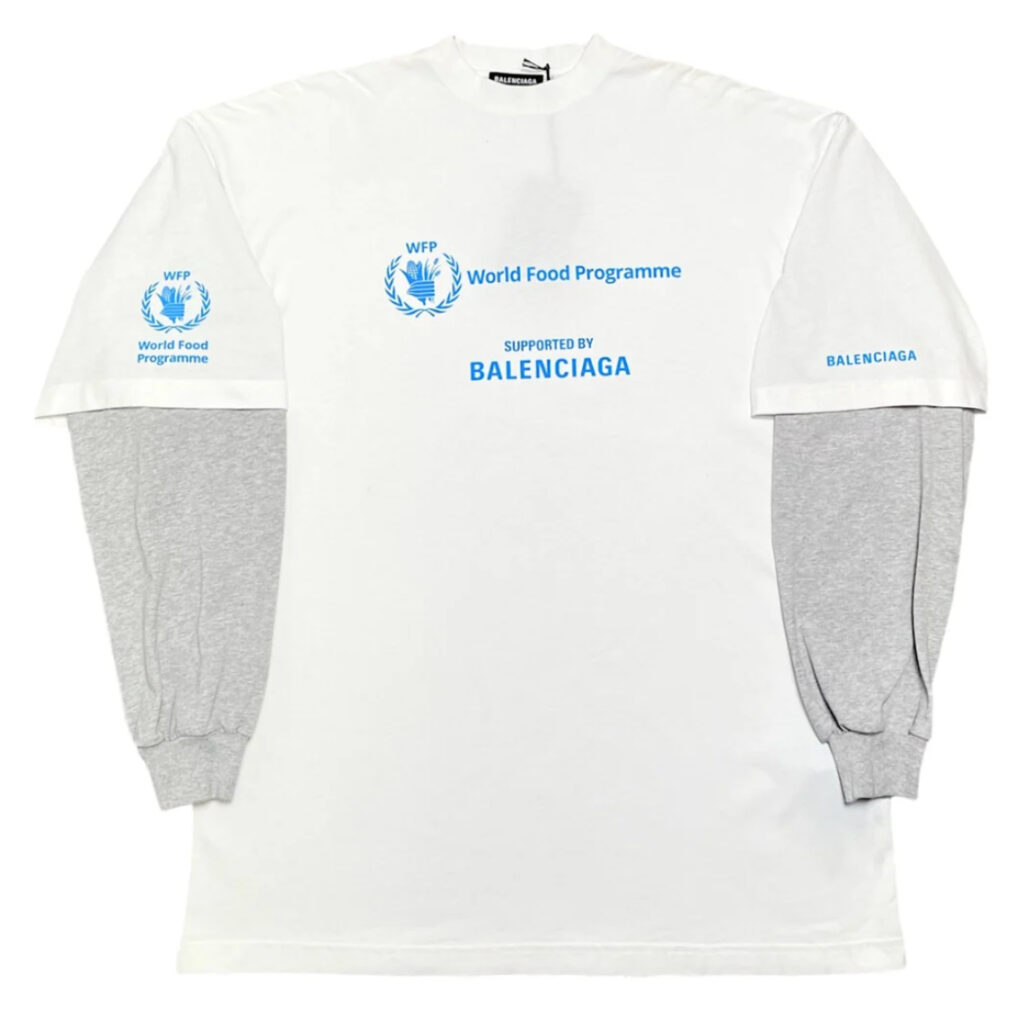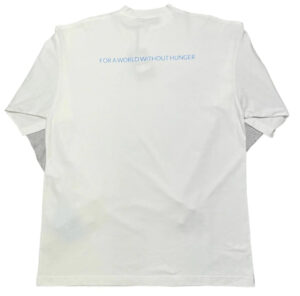In a fashion industry often accused of operating within a vacuum of indulgence, the Balenciaga x World Food Programme (WFP) connection offers a rare convergence of design excellence and humanitarian advocacy. The New WFP Long Sleeve Tee Shirt in White/Grey is not just a piece of high fashion streetwear—it is an emblem of ethical consciousness rendered in cloth fabric and context, form and function, visibility and value. Designed under the stewardship of Demna, Balenciaga’s Creative Director since 2015, this garment plays within the designer’s provocative lexicon while championing a message far greater than any runway statement.
Visual Structure: A Layered Appeal
At first glance, the tee deceives. What appears to be a simple white short sleeve shirt is actually an integrated long sleeve design, achieved by sewing heather grey sleeves beneath the white tee body—an optical illusion that is one of Demna’s stylistic signatures. The layering is both aesthetic and symbolic. It nods to the brand’s love of faux layering and oversized silhouettes, but also offers practical comfort. The grey underlayer features ribbed cuffs that gather softly at the wrists, suggesting both effortlessness and intention in equal measure.
The garment’s fit is loose and oversized, true to Balenciaga’s post-streetwear paradigm. It hangs with a drape that speaks more to attitude than tailoring—a billboard of belief rather than mere bodywear.
Typography as Testimony: The Power of Words
Across the chest, printed in bright azure blue, the front reads:
WFP
World Food Programme
SUPPORTED BY BALENCIAGA
The WFP’s official emblem—a sheaf of grain held by a stylized hand encircled by olive branches—anchors the composition, giving it the visual weight of a governmental or NGO field uniform. This is not coincidental. By embedding the World Food Programme’s iconography in an haute object, Balenciaga repositions aid symbolism into the realm of aspiration. On the sleeve, the WFP logo reappears, a reiteration that extends the message laterally, physically echoing the brand’s ethos of repetition and subversion.
The back of the shirt carries a single line, also in azure:
FOR A WORLD WITHOUT HUNGER
Minimalist and declarative, this phrase transforms the tee into a walking manifesto. It is both a prayer and a call to action—direct, humane, and unignorable.
Material and Make: Garment as Infrastructure
Constructed from mid-weight cotton jersey, the fabric is breathable, soft, and substantial. It carries the tactile dignity of luxury basics without any visible logos beyond those tied to the cause. Unlike traditional designer tees that foreground brand monograms, this one decentralizes “Balenciaga” in favor of amplifying the WFP mission—a profound inversion of priorities.
The seams are reinforced and double-stitched, as expected from a high-end atelier. The back collar reveals a woven BALENCIAGA brand tag stitched on black, offering just enough authenticity for the discerning eye without undermining the message of humility.
Notably, this is not a mass-market item. Released in limited runs, the WFP long sleeve shirt is a capsule release with a dual purpose: to raise awareness and directly support the World Food Programme’s global hunger initiatives. A significant portion of profits from its sale go directly to WFP operations, making it not just a purchase but a donation, not just fashion but a form of activism.
Conceptual Weight: Demna’s Ethical Dystopia
Demna’s version of fashion often traffics in dystopian realism—think oversized silhouettes, utilitarian boots, and mock-everyday couture. This tee fits neatly into that world. It looks like something an aid worker might wear—but costs upwards of $500, reflecting its designer origin. That tension is intentional.
By elevating an article of humanitarian branding to luxury status, Balenciaga invites its consumers to confront their complicity in global inequity while participating in its remedy. The result is a post-ironic form of charitable consumerism, where fashion doesn’t mask reality but foregrounds it.
It’s worth noting that Balenciaga’s WFP initiative began in 2018 and included hoodies, caps, fanny packs, and accessories. But this specific tee is part of a second-wave drop that carried bolder statements and a more distilled design language—less logo-centric, more cause-driven.
Culture
The shirt has been worn by numerous artists, models, and activists, including Kim Kardashian, Bella Hadid, and Kanye West during public outings. Unlike typical merch, however, the appeal of the WFP tee lies not in trendiness but in virtue signaling as fashion ideology. To wear this shirt is to broadcast awareness—of displacement, of global hunger, of economic disparity. In an age where consumption is increasingly scrutinized, garments like this allow wearers to fashion themselves as informed citizens, not just stylish ones.
The release was lauded by humanitarian publications and sustainable fashion advocates alike. While some criticized the price tag as exclusionary, others defended it by pointing out its dual function: it funds tangible aid, and it propagates an important message within influential circles.
Impression
Ultimately, the Balenciaga New WFP Long Sleeve Tee in White/Grey is not about making the invisible fashionable—it is about making it visible, period. It transforms the wearer into a walking bulletin for global hunger awareness. It questions who gets to wear whose struggle. And it argues that clothing, at its best, should not just adorn but amplify.
It is a garment that lives between worlds—between privilege and poverty, street and studio, Europe and the Global South. And in doing so, it fulfills one of the highest purposes fashion can claim in the 21st century: to act.
No comments yet.









